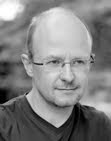
This weekend we had Imagerie's first large format workshop, led by Dutch LF specialist Hans Bol (www.hansbol.com). We were lucky to have an excellent location at Rosario in the small village of Bever in the Pajottenland (www.rosario.be).
It is a renovated monastery with atmospheric workshop rooms, a library, a chapel, a meditation room, a dining room and kitchen. The atmosphere is tranquil and reflective throughout, very conducive to creative work.
Hans led an intense workshop, sharing a lot of his practical skills and artistic outlook. We started with a more practically oriented part dedicated to setting up and manipulating a (U)LF camera (Hans' 8x10" Lotus View Camera, with an expansion frame for 8x20"), followed by discussion of processing and printing LF negatives. The latter part was complemented with the study of lots of Hans' own 8x20" contact and 4x10" enlarger prints.
After lunch, Hans reviewed a series of books (by Michael Smith, Aaron Siskind, Minor White, Josef Koudelka and Art Sinsabaugh) that have been important in his own artistic development. The late afternoon was spent on a fairly probing discussion on how the choice for technical options, particular subjects and motives have to be coherent with one's fundamental creative impetus as a photographer. After dinner, we were treated on a concert in the Rosario chapel featuring a 10-head strong male choir singing russian-orthodox sacred hymns (www.molitva.net). The concert was followed by a projection of two of Hans' portfolios: "Stop and say hello", showing 4x5" pictures (colour and B&W) taken during several trips across the US in the 1990s, and his most recent work in India ("Life is precious", featuring a mix of smaller formats).
After a refreshing night, we started again with a review and discussion of participants' portfolios. Lunch was quickly there and the workshop finished with a discussion of two emerging book projects by Hans ("Altissimo", dedicated to his expansive work in the Carrarra marble quarries (8x20" and 6x17) and the India book). Thus the workshop closed the whole cycle, starting with selecting and setting up a LF camera to the consolidation of a project in a book project.
It was a great workshop at a an inspiring location and we hope to be back at Rosario next year with another LF session.
Picture above shows Hans' Lotus camera with a 4x10" reduction frame, taken with my Wista F 4x5" on Polaroid 54.




